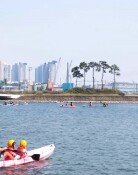U.S. closely monitors ICBM production facility in Sanumdong, N. Korea
U.S. closely monitors ICBM production facility in Sanumdong, N. Korea
Posted December. 11, 2019 07:32,
Updated December. 11, 2019 07:32
With the U.S. and North Korea ramping up their rhetoric after the North’s new rocket engine test at the Tongchang-ri site, intelligence agencies of South Korea and the U.S. have begun to closely monitor the Sanumdong missile research facility near Pyongyang. There are growing voices of concern that the U.S. and North Korea might revert back to confrontation, where the two acted touch against each other, amid the U.N. Security Council scheduled to meet in two years at the request of the U.S. over the North’s repeated provocations.
The U.S. intelligence agency has been thoroughly searching the Sanumdong area day and night using reconnaissance satellites, immediately after new activity suggesting engine tests was spotted at the Tongchang-ri site early last week, according to a South Korean government source on Tuesday. It is closely monitoring movements at the facility, including the type of vehicles going in and out of it and their routes as well as the staff going in and out of the facility to look for any signs of North Korea’s launch of long-range rockets carrying satellite and ICBM.
A military source said the Sanumdong facility is one of the two major nuclear sites in North Korea along with the Tongchang-ri site that develops and produces propellant engines for missiles, including ICBM. A close monitoring of the site by South Korea and the U.S. suggests that there is a high risk of additional provocation by North Korea, the source added. Intelligence agencies think that the rocket engine the North tested at the Tongchang-ri site on Saturday was also produced at the Sanumdong facility. Against this backdrop, the -8C Joint Surveillance Target Attack Radar System, or Joint STARS,, a U.S. Air Force airborne ground surveillance aircraft, conducted an operation flight over the Korean Peninsula on Tuesday, according to the military aircraft tracking site Aircraft Spots. Following a flight by the RC-135W Rivet Joint the previous day, the U.S. again deployed a reconnaissance aircraft to monitor North Korea.
Yong Park parky@donga.com







